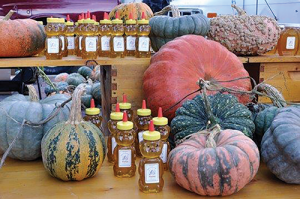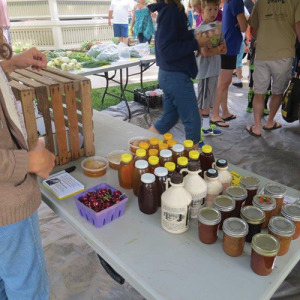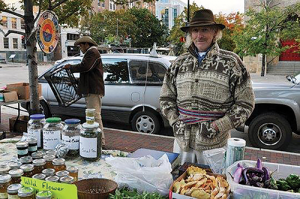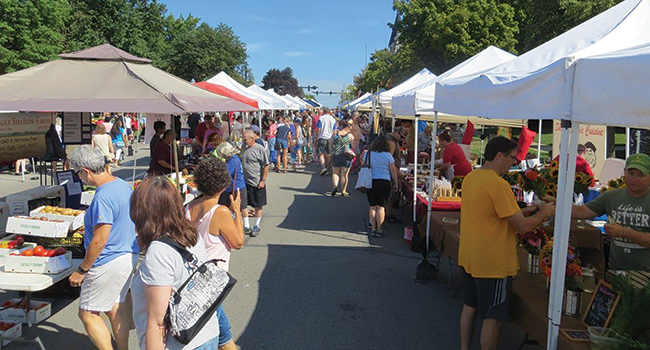
Ann Harman
Get it touch
ahworkerb@aol.com
By: Ann Harman
You have been participating in your local farmers’ market for several months now. You have your table with your jars of local honey ready for sale. How are sales going now? Still the same as when the market opened for the season? Or have the number of customers declined over the last month or so? The market is definitely busy with people filling boxes and bags with beautiful tomatoes, ears of corn, lots of different summer squashes, big and little carrots and fruits. Although many of the market customers are those who have come each year for several years, new people do appear.
The woman who bought her regular yearly purchase of a squeeze bear of honey is seen every week. She told you how delicious your honey is. But she seems to only put it in her morning cup of tea. How many teaspoons in a 12-ounce bear? A 12-ounce bear contains eight fluid ounces or 48 teaspoons. Well, if a squeeze bear lasts her a year, she is not using very much in her tea. However she comes every week and buys fruits and vegetables. She certainly could use honey in recipes with those.
When the farmers’ market opened for the season people did stop by your table and buy a jar or a bear. But that purchase seemed to satisfy their needs. Right now the bounty of vegetables and fruits seems to be taking their attention. Although you do have a few regular customers they still only buy a jar now and then. If the weather turns chilly in Autumn, sales might increase. But it would be nice if more of the market shoppers came to buy. There are many ways to attract customers. Now is the time to do something!
First of all you need to know the rules and regulations for your particular farmers’ market. Are you allowed to give taste samples? If so then you need a way to give a small sample. A very small plastic spoon and a squeeze bear may be permitted. You do the “serving” of the taste sample to keep it under control. Now you need a trash can for the spoons and a container of water and a cloth for any drips. Unfortunately insects such as flies and yellowjackets, and even local honey bees, may be attracted. In that case, do not give taste samples this way.
 If the small spoons and squeeze bear are not permitted or practical another way to provide samples would be to sell two-ounce bears. These have a small flat panel for a label. The label is necessary. It has your contact information on it. If you are able to collect varietal honeys, rows of bears with different colors of honey would make an attractive display for your table. The cap is flat so it can have a small label with the variety name. You might discover new customers. Many people, especially those used to “supermarket” honey, are quite surprised to learn honey naturally comes in different colors and flavors.
If the small spoons and squeeze bear are not permitted or practical another way to provide samples would be to sell two-ounce bears. These have a small flat panel for a label. The label is necessary. It has your contact information on it. If you are able to collect varietal honeys, rows of bears with different colors of honey would make an attractive display for your table. The cap is flat so it can have a small label with the variety name. You might discover new customers. Many people, especially those used to “supermarket” honey, are quite surprised to learn honey naturally comes in different colors and flavors.
Here is another question to ask the market manager. Can you sell flavored honey sticks (straws) at the market? It’s not your honey, of course, but they sell very well. Parents bring children to the market and the kids love the honey sticks. You may need to try several assortments of stick flavors to find which ones are popular and which ones are not. You can then just offer the popular ones. While the children (and parents, too) are selecting their sticks, the parents can be introduced to your honey varieties.
One question you may be asked by a potential customer is: “Is your honey organic?” You need to give an honest answer to that. The answer is No. You can explain that there are no standards for USDA certified organic honey produced in the USA. They do not exist. The official organic standards state that if you are not certified, you must not make any organic claim on the principal display panel or use the USDA organic seal anywhere on the package. A customer may comment that they saw (and maybe even bought) organic honey, labeled as such, in a store. You should then explain that the honey was imported from a country that has had its honey certified. Just remind them that your honey is local.
But don’t worry. The word “local” on a product is enthusiastically accepted today. You can point out your address on your honey label. Most of those who come to the market are familiar with the town name. You can say that your hives are located near that town and that the bees forage on blossoms in that area. You can buy small labels that simply say “local honey” and put them on your containers.
Another health question can be asked. Many people have heard that eating local honey can “cure” or “prevent” hay fever, an allergic reaction to plant pollen. It is very important to make no health claims! You are not a health professional nor a doctor. You can simply say they can certainly try some honey. And add that it tastes good and can be used in many recipes. You may have a potential customer that says “I am diabetic so I think I can eat honey.” Tell this person firmly, but gently, that only their doctor can say whether honey can be eaten or not. Diabetes is not just one condition. People with diabetes must follow the recommendations of their doctor.
By the way, are your jars sticky? One way to make certain is care when filling your containers. If any honey is on the threads it will slowly gather moisture from the air and slowly seep that wet honey down from the cap onto the jar. Wiping the threads with a cloth probably means that the cloth itself is depositing honey on the threads. You might not be aware of it. However shoppers really do not want to handle a slightly sticky jar. The threads of the jar must be clean, dry and free of honey before the cap is put on.
What about the containers you are using? Yes, they are one of your expenses but offering different containers may actually increase sales. Bears are generally popular and are an easy way to deliver liquid honey, especially for children. The inverted plastic jar is becoming more popular because it is not messy. You may wish to offer different sizes, such as two-pound or even five-pound jars. They are useful for those who cook with honey. The hex jars and the Muth jars make excellent containers for customers to give as gifts. The wooden honey dippers could be sold. Try different sizes and types of jars to make your honey display interesting. If your farmers’ market is open into the late autumn you can promote giving honey in a fancy container as Christmas gifts. If your honey crystallizes rather quickly then selling it too far in advance for gift giving may not be a good idea.
 If you usually only have liquid honey for sale you might wish to introduce customers to other forms – creamed, cut-comb, round sections and chunk honey. Creamed honey can have great appeal because it is not as messy as liquid. Honey in its comb is appreciated by a number of people but many have never tried it and thus have no idea what to do with it. It is possible to have small bite-sized pieces cut from cut-comb for customers to try. But it might be more practical to find some small plastic containers to hold a small piece cut from preparing cut-comb. They could be sold for a low price to those who wish a sample.
If you usually only have liquid honey for sale you might wish to introduce customers to other forms – creamed, cut-comb, round sections and chunk honey. Creamed honey can have great appeal because it is not as messy as liquid. Honey in its comb is appreciated by a number of people but many have never tried it and thus have no idea what to do with it. It is possible to have small bite-sized pieces cut from cut-comb for customers to try. But it might be more practical to find some small plastic containers to hold a small piece cut from preparing cut-comb. They could be sold for a low price to those who wish a sample.
If you are not familiar with the National Honey Board, now is the time to get acquainted with it. It is one of the USDA marketing boards who purpose is to increase the consumption, and therefore the sales, of an agricultural product. You need to go onto the website www.honey.com. When the site opens scroll all the way down and look for their e-catalog. Here you will find marketing items that can help your honey sales.
You will see two different hang tags. These have recipes using honey and can be put on all your containers, including the two-ounce bear. Then you will see various other promotional materials and the quantity you can receive free. One of the informational brochures is for kids. Then click on e-newsletter and sign up for free information and recipes throughout the year. Explore the entire NHB site so that you are familiar with it. Go back and click on Recipes and become familiar with that part of the site. New recipes are added all the time, especially seasonal ones. You can print out the recipes and make use of them.
You can select one recipe and print out a number of copies and call it your “Recipe of the Week.” Make a little poster that says Recipe of the Week for your table. If someone buys honey give them a copy of the recipe and tell them there will be a different one next week. Even if they do not buy honey each week you are giving them a way to use honey. Print up some of the recipes for kids and give those away. The children might actually eat the vegetables their parents are buying. Have a collection of different recipes set aside. If someone stops at your table and you notice they bought several cucumbers (or carrots or other vegetable or fruit) offer them a recipe for the vegetable or fruit.
You will find other sources for recipes using honey, such as on the internet. In addition some of the bee equipment suppliers sell honey cookbooks. You can have an endless supply of recipes for your Recipe of the Week.
Another addition to your sales table can be the Honey Flower of the Month. Just pick some nectar-producing flower that bees visit, wrap the stem with some wet newspaper or paper towels and display it in a container on your sales table. Label the flower with its name and tell customers that bees visit these for nectar and/or pollen. The plant may start questions about the problems bees are having with forage or pesticides. Be sure you are up to date on efforts to help bees, and other pollinators, in your area. You can refer really interested people to websites such as the Xerces Society (www.xerces.org) and Pollinator Partnership (www.pollinator.org) .
 Don’t be afraid to do something silly. August is the beginning of the bee’s year. So find a little stuffed toy bee and put a little sign by it saying “Wish A Happy New Year to The Bees.” Somebody is sure to stop, even if busy shopping, and ask about the bee’s New Year. You do not have to go into great detail about the life of bees but tell them something and give them one of your Recipe of the Week handouts and hope they are interested in buying your honey.
Don’t be afraid to do something silly. August is the beginning of the bee’s year. So find a little stuffed toy bee and put a little sign by it saying “Wish A Happy New Year to The Bees.” Somebody is sure to stop, even if busy shopping, and ask about the bee’s New Year. You do not have to go into great detail about the life of bees but tell them something and give them one of your Recipe of the Week handouts and hope they are interested in buying your honey.
Other honey bee products – candles, soaps, lotions, lip balms – sell very well. If you do not make any of these yourself, there is a beekeeper near you who does. That beekeeper may or may not be able to join you at the farmers’ market. If not, then you can make arrangements to sell these items. If you have not used these products yourself, then try each one that you plan to sell so that you will be able to answer any questions from customers.
Just remember that when you are at the farmers’ market you become an ambassador for honey bees. At the end of a day you have answered questions and listened to bee stories. As you are packing up at the end of the day, keep thinking of ways to promote honey in the kitchen. It’s the magic ingredient!
Ann Harman lives and keeps her bees in Flint Hill, Virginia. Look for her at EAS 2018.







